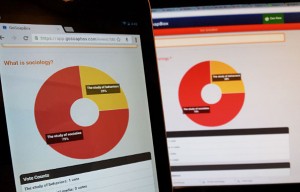
Web clickers work on a variety of mobile devices, including tablets, smartphones and laptop computers.
Teaching and Learning Technologies (TLT) is piloting new clicker technologies this academic year. Last time, we talked about traditional hardware clickers we are piloting. This post talks about a new kind of clicker that uses the internet and mobile devices.
Web clickers
A web clicker allows students to use their own mobile device to respond to a prompt. The mobile device can be any device with an internet browser and a Wi-Fi connection – any laptop computer, any tablet and nearly any smartphone. Other than the students’ device, no special hardware is required.
Web clicker vendors
 There are many web clickers available right now. Here is a comparison of web-based clickers generated by Poll Everywhere, one of the oldest web clicker companies. We are partnering with GoSoapBox in our clicker pilot because of its healthy feature set and the ability to manage polls from a mobile device – no computer is required.
There are many web clickers available right now. Here is a comparison of web-based clickers generated by Poll Everywhere, one of the oldest web clicker companies. We are partnering with GoSoapBox in our clicker pilot because of its healthy feature set and the ability to manage polls from a mobile device – no computer is required.
Web clickers are recommended for instructors who want:
- Students to use a laptop, tablet or smartphone in their class
- To use their own iPad or Android tablet in the classroom
- Students to contribute short-answer responses in addition to multiple choice responses
- To create a private backchannel where students can ask questions during a lecture or class discussion
- To monitor student comprehension in real-time during a course session
- To create mobile-friendly quizzes that students can complete anytime
- To encourage students to ask questions and interact outside of class time
Many of the advantages above are true of most web clickers, including GoSoapBox. There are some disadvantages of using student-owned mobile devices and Wi-Fi for clickers.
Disadvantages of web clickers:
- Access: all students may not have a Wi-Fi enabled mobile device
- Response time: Student responses can take a few extra seconds to appear
- Distraction: Students could use their own device for non-academic uses: Facebook, texting, etc.
- Overload Wi-Fi: Large classes could overload the classroom Wi-Fi and prevent some students from participating
Web enhanced hardware clickers
Many hardware clicker vendors also offer a web clicker option. The vendors in our pilot, TurningPoint and iClicker, give students the option to use their mobile device as a clicker. Students using their mobile device or a traditional clicker will all have a very similar experience – which is good and bad. Good because everyone participates in the same basic polls, regardless of the device they use. Bad because mobile devices can do a lot more than just respond to a multiple-choice question. Web-only clickers have unique features that are possible because everyone is on a mobile device.
What’s next?
Look for upcoming posts with Elon faculty talking about their experiences with clickers.
Interested in trying clickers?
If you are an Elon University instructor and are interested in testing out clickers during the Fall 2012 semester, let us know. We can get you set up with either hardware or web-based clickers and provide assistance with ways to incorporate them into your instruction.
Do you have any experience with any of the clicker systems? Let us know about your experiences in the comments section below.
Image by me…feel free to re-use it under the Creative Commons BY 2.0 license.








 Follow
Follow